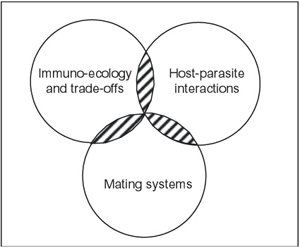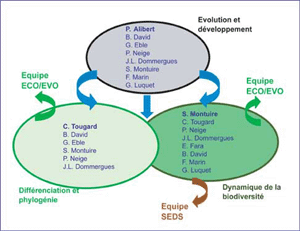Biodiversity emergence and maintaining Team leader: Nicolas Navarro Assistant: Stéphane Garnier The Evolution and Development axis focuses on the study of developmental processes at various taxonomical scales. Some projects at the macroevolutionary scale concentrate on the role of ontogenetic modifications on morphological expression and The EVO/DEVO approach is of particular interest for research questions at a macroevolutionary scale. The emergence of large-scale organisational plans, the study of developmental constraints, the structuring of morphological space or the use of the Various projects centred on three major aspects of development are included under this heading. Phylogenetic approaches, combined with ecological, geographical or behavioural information, allow the general causes of differentiation to be studied. The task of obtaining well-resolved phylogenies that are operational therefore seems primordial. These diverse phylogenetic approaches are necessary to identify general tendencies and to consider all the processes leading to specific diversity among clades (the biodiversity dynamics axis). Two groups of projects are identified under this heading. The aim of this research axis is to describe and analyse biodiversity dynamics on various spatiotemporal scales. More specifically, this will mean the structuring of diversity (morphological, genetic, or specific) with palaeoenvironmental variations at local, regional and global scales. The contribution of the temporal dimension to the study of evolutionary processes will then allow the study of biodiversity fluctuations in periods of crises (extinctions, migrations) and reconquest. Two major themes are included under this heading. With the ECO/EVO group With the SEDS group
Research
 The
The
main research questions of the FED group concern biodiversity, its implementation, diversification and maintenance, from the level of the individual up to the clade, integrating various spatiotemporal scales of analysis, and using several parameters to describe biodiversity (morphology, taxonomy and genetics). There is considerable interaction between the three main axes, focusing on specific domains: evolution and development, differentiation and phylogeny, and biodiversity dynamics.1. Evolution and development
macroevolutionary dynamics. Other projects concentrate on the study of modularity and morphological integration at the clade scale, or at a finer scale. The third group of projects is at the microevolutionary scale, focusing on the study of mechanisms controlling development stability. The morphometric approach, shared by all these projects, has earned international recognition for the laboratory. The genetic facet can also be integrated through external collaboration.
temporal dimension of development in the understanding of divergences between species (heterochronism), are themes which may now be re-examined in the light of new morphometric approaches. More recently EVO/DEVO has also endeavoured to answer questions about microevolution.
The characterisation of phenotypic variation and the understanding of the processes that determine its origin and control are the focus of this research.
– Biomineralisation and ontogenesis
model organisms: bivalves, crustaceans
– Morphological space and ontogenetic disparities
model organisms: extant and fossil cephalopods
model organisms: echinoderms, cephalopods, rodents
model organisms: sea urchins, ground beetles, fruit flies (Drosophila)2. Differentiation and phylogeny
The validity of studies dealing with differentiation of populations, speciation and phylogenetic relationships is heavily dependent on the quality and quantity of morphological or genetic data. Defining a character or a number of informative characters is a prerequisite to the study of the evolutionary history of taxa, whether individuals within populations, populations, subspecies or species. Estimating levels of differentiation (e.g. morphological, genetic, karyological) between individuals or populations remains a key problem. A general appreciation of the mechanisms that induce differentiation, or, on the contrary, create homogeneity in populations, is important for the understanding of how diversity (genetic or morphological) is structured.
model organisms: rodents, sea urchins
What
do phylogenies reflect? Do the differences between taxa coincide with
specific events such as great environmental changes? How and in what
context do species become established?
How is the morphological pool of a species organised and what information can be gathered about events affecting its history?
model organisms: echinoderms, cephalopods3. Biodiversity Dynamics
model organisms: molluscs
The
general aim will be to classify in families the proteins of calcifying
matrixes, depending on their primary structure but also their function
in mineralisation, and to propose a coherent model of carbonate
biomineralisation.
model organisms: rodents, molluscs, echinoderms
Projects
will seek to test various models of community response to environmental
change and will examine 1) collections of Jurassic and Cretaceous
invertebrates, 2) biodiversity and global change through the example of
Antarctic echinoids, and 3) the impact of climate change on biodiversity
and also on morphological and genetic evolutionary rhythms in voles.Interface projects
 There will be three interface projects, one with the ECO/EVO team, the others with the SEDS team.
There will be three interface projects, one with the ECO/EVO team, the others with the SEDS team.
– Interactions between organisms: the impact of symbiotic associations on biodiversity in extreme environments.
– carbonate biomineralisation and organo-mineral diagenesis
– the LIAS project
- extrait:
- lien_externe:
- kc_data:
- a:8:{i:0;s:0:"";s:4:"mode";s:2:"kc";s:3:"css";s:0:"";s:9:"max_width";s:0:"";s:7:"classes";s:0:"";s:9:"thumbnail";s:0:"";s:9:"collapsed";s:0:"";s:9:"optimized";s:0:"";}
- kc_raw_content:
